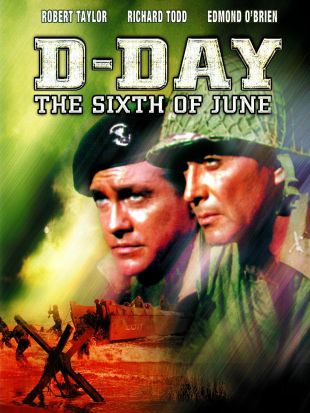
Henry Koster was a seemingly improbable choice to direct D-Day The Sixth Of June -- although he'd worked in several different film categories in a career dating back 25 years, including religious melodrama, fantasy, and drama, his greatest success was as a maker of comedies, usually built around younger female protagonists such as Deanna Durbin et al. That said, he does an amazingly good job with a movie that is told almost entirely in flashbacks from the early morning hours of June 6th, 1944, aboard a ship sent in ahead of the first units of the main invasion force. Koster knew how to use the CinemaScope frame better than almost anyone in Hollywood, having helmed Fox's debut widescreen entry, The Robe (1953). D-Day The Sixth Of June is filled with beautifully composed shots: The close-ups of Robert Taylor and Dana Wynter in their first lunch together, with a violinist joining the shot for a moment of comic relief; Taylor and Wynter by the river as the ships move past, which is also exquisitely lit; the reunion between Taylor and Wynter 54 minutes into the movie; Taylor and Wynter kissing against a backdrop of barbed wire on the British coast; and Taylor and Wynter's farewell; the sequence in the Brigadier's home, with actor John Williams on the extreme left the frame at the dramatic nexus of the scene, with Wynter on the extreme right; the scene in which Edmond O'Brien's rival enters O'Brien's office, only the eagle shoulder insignia visible, instantly telling us of his new promotion and the end of thetwo officers' bitter rivalry; and most of the battle scenes. Indeed, Koster and cinematographer Lee Garmes did their jobs so well in creating a solid, substantial CinemaScope release, that D-Day The Sixth Of June proved impossible to appreciate in the decades of television showings that have followed, its image heavily cropped. In that regard, the DVD release is a godsend. The movie has its flaws, to be sure, including the 19 year age difference between Taylor and Wynter and the fact that Taylor, by the time of the D-Day invasion, with three years of soldiering behind his character, looks like the oldest captain in the United States Army. On the plus side, the script does capture the genuine ambivalence of the British to the presence of the Americans as they began arriving in 1942, and has the temerity to mention such unmitigated disasters as the raid on Dieppe (which nearly sank Churchill's government); and it delves into the darker side of the motivations behind some of the Americans serving in England, including the desire for personal aggrandizement and glory-hunting. The irony is that D-Day The Sixth of June is an infinitely better account of the two and a half years leading up to the invasion, than it is of the invasion.
